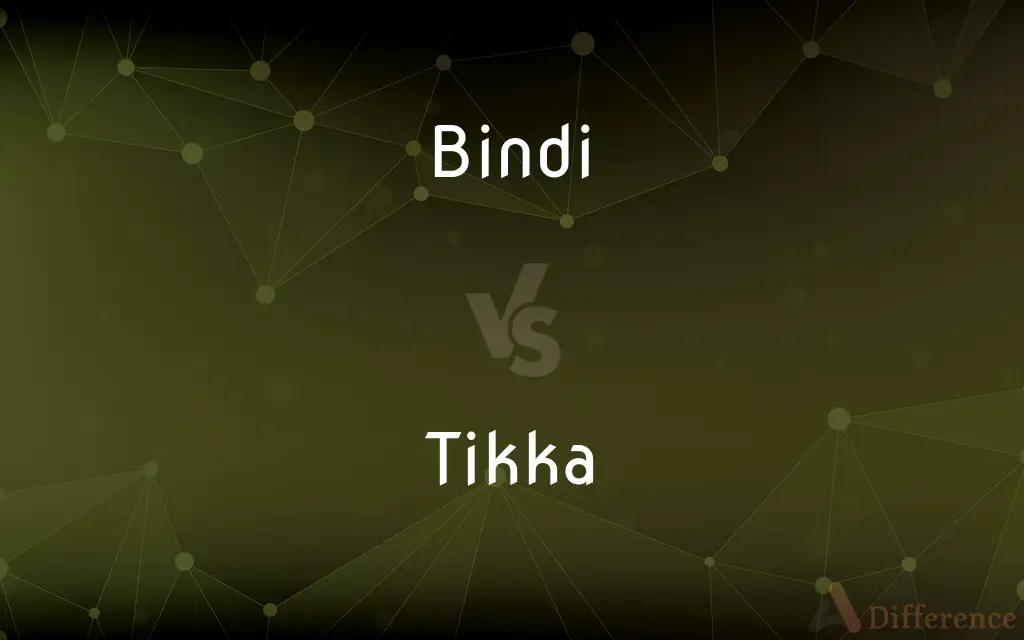Bindi vs. Tikka — What's the Difference?
Edited by Tayyaba Rehman — By Urooj Arif — Updated on April 20, 2024
Bindi is a traditional mark worn on the forehead by Indian women for cultural significance, while Tikka is a ceremonial mark used during religious or important social rituals.

Difference Between Bindi and Tikka
Table of Contents
ADVERTISEMENT
Key Differences
Bindi is primarily a decorative dot or mark worn on the center of the forehead by women in South Asia, symbolizing marital status or an ethnic identity. Whereas, Tikka, also placed on the forehead, is used by both men and women during religious ceremonies or significant occasions like weddings or festivals, serving as a blessing and a mark of honor.
Bindi is often self-adhesive and comes in various colors and designs, reflecting personal style or social trends. On the other hand, Tikka is usually made from a paste of red turmeric powder and rice, signifying purity and spirituality, and is applied during specific rituals.
The tradition of wearing Bindi is ancient, rooted in Hindu culture, and has evolved into a fashion statement among women of various backgrounds. In contrast, Tikka holds a more uniform spiritual significance across different regions, predominantly used to signify the participation in a religious or cultural ceremony.
While Bindis are worn daily by many women as a part of their routine attire, especially in traditional settings, Tikkas are typically reserved for particular events and are not part of everyday wear.
In modern fashion, Bindis have been adopted internationally, seen in global fashion shows and pop culture, diverging from their traditional cultural roots. Conversely, Tikkas remain closely tied to their ceremonial roots, rarely seen outside the context of their specific cultural and religious usage.
ADVERTISEMENT
Comparison Chart
Usage
Decorative and cultural significance
Ceremonial and religious significance
Gender
Primarily worn by women
Worn by both men and women
Material
Adhesive stickers, jewels
Turmeric, sandalwood paste
Occasions
Daily wear, social gatherings
Religious ceremonies, weddings
Cultural Significance
Marital status, fashion
Blessings, spiritual protection
Compare with Definitions
Bindi
A small decorative mark worn on the forehead.
She chose a red bindi to match her saree.
Tikka
A mark made with colored paste during religious ceremonies.
He received a saffron tikka at the temple ceremony.
Bindi
A cultural identity marker in South Asia.
At the international fair, she wore a bindi to represent her heritage.
Tikka
Associated with major Hindu festivals.
During Diwali, families apply tikka during the puja.
Bindi
A symbol of marital status among Hindu women.
Her bindi, a sign of her recent marriage, was prominently displayed.
Tikka
Represents spiritual protection.
She wore a tikka to seek divine protection during the pilgrimage.
Bindi
A fashion accessory in modern attire.
She wore a crystal bindi to the music festival.
Tikka
A symbol of honor and blessing.
The priest applied a tikka to each devotee's forehead.
Bindi
A cosmetic feature in traditional dance forms.
The classical dancers wore large, ornate bindis for their performance.
Tikka
Worn by both genders during special occasions.
Guests wore tikkas at the traditional Indian wedding.
Bindi
An ornamental dot traditionally worn by Hindu women in the middle of the forehead or between the eyebrows, made of colored sandalwood paste, kohl, or other pigment and having varying religious and social significance, as in indicating marital status.
Tikka
A pendant attached by a chain so as to hang from the parting of the hair to the middle of the forehead, worn especially by Hindu brides.
Bindi
A small body adornment, often a colored or jeweled sticker, worn on various parts of the face and body.
Tikka
A bindi.
Bindi
The “holy dot” traditionally worn on the forehead of Hindu women.
Tikka
A South Asian dish consisting of pieces of chicken or other meat marinated in yogurt and spices and cooked on a skewer.
Bindi
Makeup or jewellery worn in imitation of such a dot.
Tikka
A marinade made from various aromatic spices usually with a yoghurt base; often used in Indian cuisine prior to grilling in a tandoor.
Bindi
(Australia) The common lawn weed, Soliva sessilis, introduced to Australia from South America.
Bindi
(Australia) A seed of this plant, having small sharp spines which stick painfully into bare feet.
Bindi
(Australia) Any of a number of plants of the genus Calotis which have small burrs with fine barbed awns.
Bindi
(Australia) Any of a various plants of the genus Sclerolaena.
Common Curiosities
What is the significance of a bindi?
A bindi traditionally symbolizes marital status and is also a fashion statement.
What materials are used to make a tikka?
Tikkas are commonly made from natural substances like turmeric or sandalwood paste.
Is tikka restricted to Hindu ceremonies?
Primarily yes, tikkas are used in Hindu ceremonies, though similar practices exist in other cultures.
How is a bindi applied?
Bindis are self-adhesive and can be applied directly onto the forehead.
Can a tikka be worn daily?
Tikkas are typically worn during special occasions and not for daily wear.
Can a tikka be of any color?
Traditionally, tikkas are red or yellow, but variations exist depending on the region and occasion.
Are there any age restrictions for wearing a tikka?
There are no age restrictions; people of all ages can wear tikkas during ceremonies.
Can men wear a bindi?
Traditionally, bindis are worn by women, but fashion trends can vary.
Does the color of a bindi have specific meanings?
Yes, colors can signify different meanings, such as red for married women.
Can non-Hindus wear bindis or tikkas?
Yes, while rooted in Hindu tradition, non-Hindus may wear them, often seen in cultural appreciation contexts.
Are bindis and tikkas considered essential in Indian weddings?
Yes, they play significant roles in traditional Indian wedding ceremonies for both brides and guests.
What does wearing a tikka signify?
Wearing a tikka signifies receiving blessings and participating in a religious ritual.
Is it appropriate to wear a bindi or tikka to a non-Indian event?
This depends on the context and cultural sensitivity of the event.
How has the use of bindis changed in modern times?
Bindis have evolved into a global fashion accessory beyond traditional contexts.
Do bindis have any religious significance?
Bindis have cultural and sometimes spiritual significance but are not strictly religious.
Share Your Discovery

Previous Comparison
Audaciousness vs. Audacity
Next Comparison
Athletics vs. SportsAuthor Spotlight
Written by
Urooj ArifUrooj is a skilled content writer at Ask Difference, known for her exceptional ability to simplify complex topics into engaging and informative content. With a passion for research and a flair for clear, concise writing, she consistently delivers articles that resonate with our diverse audience.
Edited by
Tayyaba RehmanTayyaba Rehman is a distinguished writer, currently serving as a primary contributor to askdifference.com. As a researcher in semantics and etymology, Tayyaba's passion for the complexity of languages and their distinctions has found a perfect home on the platform. Tayyaba delves into the intricacies of language, distinguishing between commonly confused words and phrases, thereby providing clarity for readers worldwide.
















































